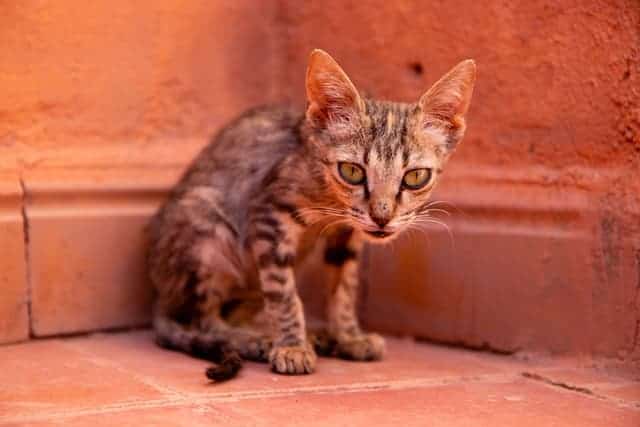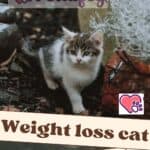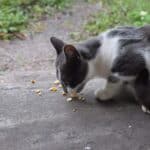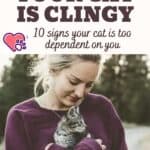Is your cat too thin and you don’t know what to do? Here is what could be the causes of thinness and how to increase its weight.

We all agree that the cat must keep fit, supported by a correct and healthy diet and also by doing physical activity. But sometimes the problem can be the opposite, that is an excessive thinness that inevitably also affects its growth. How to understand if and why your cat is too thin and how to help him get back in shape with the right advice.
The cat is too thin: symptoms of excessive thinness
Knowing if the cat is too thin or if it is simply a normal weight cat is quite intuitive.
However, difficulties may arise, due to the fact that you are a novice in the approach with a feline, or that the cat is elusive and difficult to approach.
For this reason, it is important to know all the clues to pay attention to, to understand if you are really dealing with a cat that is too thin.
In this case, in fact, timeliness is everything: it will be necessary to intervene immediately for the well-being of the cat. Let’s see what are the symptoms of excessive thinness in both puppies and adult cats.
The kitten is too thin
It is normal for a kitten to be small as it is not yet developed and obviously has a different build than an adult one.
But when can this small being of yours be defined as ‘excessive thinness’ bordering on underweight?
A newborn kitten should weigh around 100g, although this factor depends a lot on the breed (and size) of its parents, but also the health conditions of the mother cat during delivery and how they were nursed immediately after birth.
If after the first week the weight should have doubled, by the third week it should reach 300 g and by the first month of life it should be about half a kg, to reach almost 1 kg after the first two months.
However, if you realize that your kitten’s weight is struggling to rise and in general its appearance appears to you not very fit and healthy, it is better to contact an expert veterinarian and expose the problem to him.
It is likely that there was some problem with the intake of breast milk or you have had some gastrointestinal parasitic infection. Even in the physical aspect we can identify signs that something is wrong:
- you can see the ribs,
- you see the bones,
- you can count his bones,
- the body is small and there is little flesh,
- the thorax is prominent.
The adult cat is too thin
The average weight of the adult cat should be between 3.6 and 4.5 kg. Of course, these are approximate indications, as a lot depends on the size of the cat, as well as on gender and age.
Unfortunately, there is no body mass index for cats, as there is for humans. So the best way to tell if a cat is too thin is to look closely at it.
Basically, without taking into consideration the opposite pathological condition, namely obesity in the cat, it is possible to identify three types of feline silhouette:
- Weight form, when the ribs of the cat are perceptible only to the touch, the hips are visible but very full and the vertebrae are not visible or perceptible to the touch;
- Slender cat, when it is possible to feel the vertebrae to the touch;
- Cat too thin, if the ribs and vertebrae are visible to the naked eye, the hips are angular and the breastbone is noticeable to the eye.
In addition to excessive thinness, an underweight cat exhibits a different behavior than its peers. Given his condition, in fact, he appears weaker, less active and very dejected, to the point of bordering on depression.
The cat is underweight: the causes to be investigated
If the cat is not only too thin, but is unable to gain weight, then we need to understand what the problem is and the best solution to ensure that this does not hinder the feline’s health.
The first area in which to investigate is nutrition: if it is scarce or made up of low-quality and poorly nutritious products, we cannot expect the cat to gain weight!
If, on the other hand, the food is excellent and suitable for its needs, it could be that the cat does not assimilate it well or sufficiently: it could therefore be a problem in the mouth (for example a toothache or an ulcer) or an emotional factor.
In fact, when he feels stressed or uncomfortable, the cat’s stomach tends to close and make him become inappetence.
Unfortunately, the cause could also be linked to a health problem, because some diseases have among the effects a poor appetite that stops growth. Among the main pathologies that cause excessive thinness in cats are:
- Diabetes mellitus;
- Hyperthyroidism ;
- Stomatitis;
- Worm infestations;
- Digestive disorders;
- Chronic renal failure.
Underweight cat: tips and remedies

The first thing to do if your cat is too thin is to take him to the vet. The professional, in fact, will be able to identify the cause of the underweight in the cat, indicating how to intervene.
If the underweight of your four-legged friend is attributable to a pathology, you will only have to rely on the veterinarian and proceed with the best care to ensure that the cat returns in strength.
If the too thin cat is a puppy, the problem is most likely its feeding. For this, you have to choose the right foods for the kitten that needs to grow.
If up to the third week the ‘problem’ is solved with breast milk or substitute milk (if the mother cat has problems with breastfeeding), it is better to seek advice from the doctor on the choice of food for the weaning phase.
They should never be lacking in your diet: vitamins, proteins and minerals. The nutrients will make your physique stronger and less prone to disease. Let’s also take care to give the cat soft and easy-to-chew foods.
Besides choosing the best and age-appropriate food, what else can we do for our four-legged friend?
First of all, to make mealtime more pleasant and simpler: small doses and always fresh water, perhaps even letting him try some hitherto unknown taste.
Better to choose a quiet and peaceful environment for the moment of the meal, away from sources of noise, distractions and disturbances (such as the proximity of children).
Don’t pressure him or make him uncomfortable, as he may also react by moving away from his bowl.






